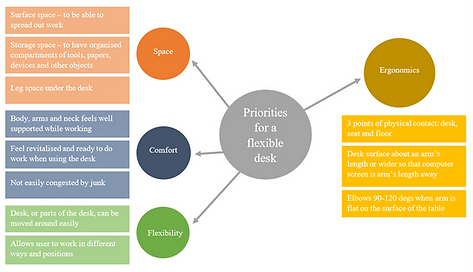.png)
Mon Combi
Summary
A "Herman Miller x Apple workspace of the future" concept for small home spaces that takes into consideration human biomechanics and seeks to optimise productivity. Mon Combi's unusual structure allows it to be used either when sitting on chair or floor.
Individual
Year: 2021
Scope: 4 weeks
Category: Furniture design
Skills Used:
-
Sketching
-
Photoshop, Illustrator
-
Biomechanics Research
-
Solidworks (CAD Modelling)
Design Brief
To design a workspace solution that optimises productivity, is functionally advantageous and takes into consideration human biomechanics with respect to any of the following scenarios:
> Home office/ working from home
> Collaborative work furniture for commercial spaces
> Inspiring creativity through workstation design, can be home or commercial
> Flexible furniture e.g. for work, home, adaptability to situation, social distancing etc
Chosen Scenario
A multipurpose, flexible solution for users who regularly work from home, in challenging spaces.
Background
An effective work furniture needs to be flexible to allow people the ability to do a variety of things as well as change the position of how they work every now and then. Height adjustable furniture, modular desks and customisable workstation systems have been implemented in office work environments to improve work efficiency and comfort.
However, furniture for home use will differ widely due to various user and spatial requirements. A home workspace can be in any room and thus need to integrate with the other exiting furniture in the room. The furniture may be used specifically by one person or by different people of various ages, and they all might have different needs. It may be difficult to encapsulate these requirements into a single piece of furniture to make it flexible in the home. This is especially so for shelving, storage compartments and desks – furniture that are required to be large to be useful.
Herman Miller x Apple
Herman Miller designs put emphasis on beauty and usability. Each of their solutions fulfill a purpose that aims to elevate experience of work for people and revitalise how people work. They often focus on creating simple, elegant solutions that are adaptable to the environment.
The work from home furniture that Herman Miller offers are incredibly flexible for the space they are designed for. The desks are simple, light solutions with plenty of organised storage and surface available to spread out work equipment. Similarly, Apple honours user experience across all their products and services. Their products and interfaces are beautiful, intuitive and useful, designed for flexibility and accessibility.
Analysis of Home Workspace
I used my room as a representation of a challenging environment. This includes measuring the overall dimensions of the room, the work furniture that I use, an analysis of light conditions and range of motion allowed. A list of priorities was mapped following the analysis.


Mood Board
A collage of furniture and aesthetics that resonate with the practical, modern styles inherent of Herman Miller and the minimalist, clean essence of Apple products. Herman Miller's
desk designs primarily feature an expansive thin timber surface over toothpick-like legs, like the Canvas Vista workstation and Nelson Swag Leg Desk (both pictured in the opposing right corners). There are also desks like the Eames Desks and storage units which featured cross metal supports over open storage "cabinets". The latter two desks inspired the overall structure of the Mon Combi.

Concept Sketches

I originally envisioned a wall-mounted design; however they would not be flexible in terms of height positioning. I considered having collapsible surfaces to be able to maximise/minimise space in the limited space of my room, however that does not seem to align to Herman Miller and Apple’s value for “simplicity”. Then I thought about how I sometimes work on the floor to have a change of environment and looked for Japanese desk designs. The traditional floor desks had a unique shape that reminded me of the upper part of the Japanese character “門”, which inspired me to create a desk that stands on a desk.
Final Concept

